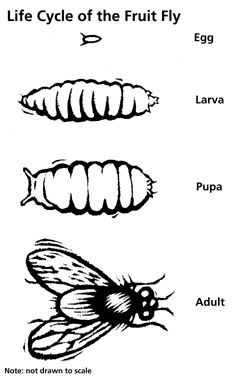Night Creatures of the Kalahari
|  |
Student Handout |
Life in a Bottle
In any ecosystem, animals rely on one another to
survive. The balance between predator and prey is an important one. Observe
your own predator-prey chambers to find out what happens when this balance is
upset.

Procedure
Copy the chart for recording observations on a separate sheet of paper. Feel
free to add other categories, such as a place to draw pictures of the
animals. Look closely at each one of your four Food Chain Chambers. Use the chart to
record what is in or is missing from each chamber. Place the chambers in an area likely to attract fruit flies. (Since fruit
flies are attracted to decaying fruit, kitchens and compost piles are a good
bet.) Once you trap a healthy population of adult fruit flies, the females will
lay eggs on the fruit in the fruit fly area. Fruit flies develop from egg to
adult in about two weeks. If you look closely you may be able to see eggs,
small active larvae, and immobile pupae. Each week describe what you observe in each chamber, and make predictions for
the following week. Be sure to make predictions for everything in the chambers:
the banana slices, the fruit flies, and the spider. After the final week, describe what happened in each chamber and explain why
you think it happened.
|
Control Chamber 1
spider: yes
fruit: yes
access for fruit flies: yes
|
Control Chamber 2
spider:___
fruit:___
access for fruit flies:___
|
Control Chamber 3
spider:___
fruit:___
access for fruit flies:___
|
Control Chamber 4
spider:___
fruit:___
access for fruit flies:___
|
Today's Date:___
Describe each chamber
|
|
|
|
|
Week 1:
Prediction
|
|
|
|
|
Week 1:
Observation
|
|
|
|
|
Week 2:
Prediction
|
|
|
|
|
Week 2:
Observation
|
|
|
|
|
etc...
|
|
|
|
|
|
